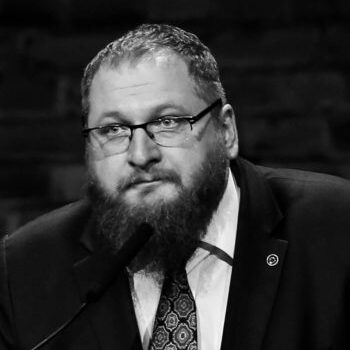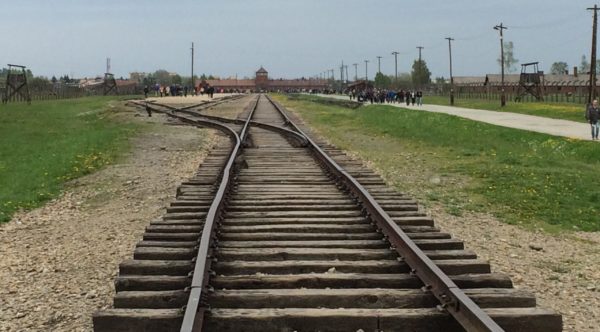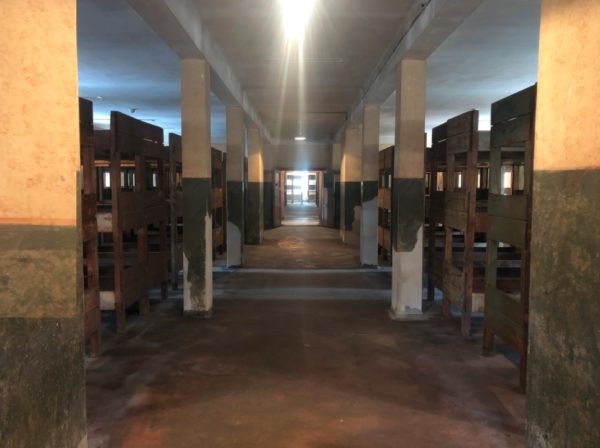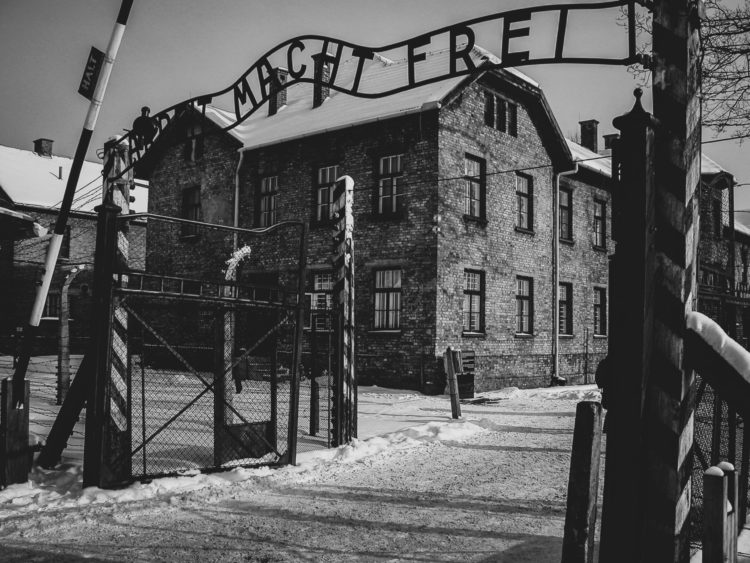Is it possible to tell the story of Auschwitz, the abyss at the center of the twentieth century? When I wrote “One Long Night,” a history of concentration camps around the world, my central question was “How did humanity get to Auschwitz, and where did it go from there?” After looking at camps on six continents, I tried to answer that question. Yet the black hole of Auschwitz itself still sat at the heart of my book, in many ways as bleak and incomprehensible as ever.

“Auschwitz: A Monograph on the Human,” a 2022 book by Piotr Cywiński, tries to address that abyss. He does so not by working his way along the boundaries around Auschwitz — the dates and architecture of genocide that swallowed more than a million people, the overwhelming majority of them Jewish — but instead dives into the emptiness itself, gathering details from hundreds of memoirs and official testimonies, along with trial minutes and questionnaires. Chronology doesn’t serve as the organizing principle; instead, the book is divided into themes of human emotion and experience, such as “Decency,” “Hierarchy,” and “Fear” that emerged from looking at the survivors’ accounts as a whole.
Cywiński is a historian and has been the director of the Auschwitz-Birkenau State Museum in Poland for more than 16 years. His polyphonic approach of bringing in hundreds of voices to tell one overarching story struck me as an answer to the question of how to write about something as vast as incomprehensible as Auschwitz.
This focus made me think of Pulitzer winner Katherine Boo who, in talking about her book “Behind the Beautiful Forevers,” balked at the idea of the journalistic impulse to make an individual a symbol of a place or an event. In a 2012 interview Poynter.org, she warned of the dangers of using one person’s story to represent a bigger concept:
“Nobody is representative. That’s just narrative nonsense. People may be part of a larger story or structure or institution, but they’re still people. Making them representative loses sight of that.”
Cywiński’s Auschwitz monograph illustrates this idea elegantly, gathering related observations with care then ceding nearly all his book to camp prisoners themselves, letting their archival testimonies converse with one another, with minimal interpretation and explanation.
Last December, more than 80 years after Nazis first sent prisoners to the small town of Oświęcim in Poland, Cywiński sat for a public interview with me at the Kosciuszko Foundation in New York. We spoke about why some stories went untold for decades, why understanding life at Auschwitz remains almost impossible and why it’s important to include a multitude of perspectives to even begin to glimpse the real story of Auschwitz.
Here are some excerpts from our conversation, which have been condensed and edited for clarity:

You mention several times in the book the experience of prisoners entering a different world on arrival at Auschwitz.
This is extremely important, and I think that this was maybe the main reason why so many survivors started to speak about Auschwitz so late. And still, 95 percent of survivors didn’t speak, didn’t give testimonials, didn’t write any memoirs. I think that they were afraid that using words from our normal world would never give the sense of the reality of the camp.
When I’m hungry, it doesn’t mean the same as when you are hungry in the camp. It’s completely different, and it’s like this with many other emotions, because they are at an extreme that we can’t imagine in our world. You’re put in a situation when the most important factors, like space and time, are completely different. You don’t know how long you will survive. When you’re speaking about hope, it means some plans for the future, but in the camp it means to survive for the next five or ten minutes. And at every moment, somebody is dying around you. That means you will also die, perhaps in a few minutes or in one hour. It’s a completely different kind of time than we experience in normal life.
At the beginning, I was thinking that I would speak about death at the end of the book. This was an error. In Auschwitz death did not happen at the end; it was present at all times and everywhere.
One of the essays in the collection is on death. There’s a quote from a survivor: “not only is life and human dignity violated here but human death counts for nothing.”
For us, death is so tragic. It’s a big mystery. We will arrive all of us at one moment to face our death, but it’s something that we consider with a religious or para-religious approach, with a philosophical approach, even if we if we don’t want to organize our lives according to this destination.
In the camp death was everywhere and could arrive at every moment. Maybe the only thing that they were sure of was death. It’s also completely different when it’s an inverse point to our way of thinking about death. If I ask what you’re sure about in the immediate future, you would tell me about how you will go back home and get dinner or do something with your family. But nobody would be thinking about death as something that we can be sure of happening in the present moment.
One quote from another testimony says: “Among the Auschwitz prisoners who wrote their memoirs none of them claims the camp ennobled people.” Yet it’s woven into a lot of fabric of society before and after Auschwitz that suffering brings a kind of nobility, that there is something inherent in suffering that makes us pure or better. I think it’s important that is not what’s reflected in most of these testimonies.
Yes, this perspective is present in very few testimonies. What we consider as a moral system in our society was completely different when it was recreated inside the camp. I think it was also a factor in the incapacity to speak about Auschwitz for many survivors because they begin to justify themselves, and they don’t want to justify themselves. They knew that their choices inside the camp — daily choices, I do not speak about dramatic choices — the daily choices were how to survive, to have one or two or three or days more to stay alive.
The position where you stand at the queue in order to have your soup: If you go at the starting point of the distribution of the soup, you will receive only water; if you go at the end, you’ll be beaten by some very well-positioned prisoners, some kapo or some people from the blocks, because they know that at the end, there will be some potatoes. So you have to find your own position, not too quickly and not too late. But that means you will take this place from some other prisoner. And with every choice you made, that means somebody else did not get this choice.
You also address the Sonderkommando — these people who were drafted into being active participants in the murder of other prisoners at Auschwitz.
It’s perhaps the most tragic history in the camp, the story of the Sonderkommando. They were in general young men taken from different transports and put to work around the gas chambers and the crematoria. They had to burn corpses, to make all this machinery function. A clear majority were Jews, and many of them were coming from Jewish Orthodox families, and cremation of course was something they couldn’t have imagined. For decades after the war, they were considered maybe not as perpetrators but as collaborators of perpetrators, except two or three, like Shlomo Venezia or Filip Müller. Many of them stayed silent for years.
We are all very proud of our culture, our education and our sense of values. We feel really prepared to confront difficulties. Those people also, certainly they were thinking like this. But a few days were enough to change a person arriving from a normal world to a person completely acting according to the camp rules, thinking in a different way, approaching other humans in a different way, considering himself as a completely different person.
Another example of a theme that we in our world might think of quite differently than the voices we hear in the book is this idea of sacrifice. I want to speak specifically about Father Kolbe, because many people have heard about this story, and he was canonized later for switching places with a condemned person. Here’s what one of the survivors said about him: “I must stress that what impressed us was not that he gave up his life for someone else, for life wasn’t worth much in the camp. We were impressed that in front of so many SS men and prisoner functionaries, he had broken discipline and dared to step out of rank.”
It’s quite different than what we might think. I heard many words like this. “If you give your life for another, that does not mean you give your life. You give your last few days or a few weeks, it’s not something exceptional. But breaking the rules, it is something, yes.”
And there were, of course, different levels of sacrifice. You can share, for example, your bread. So you have some bread. Your kid or your friend for some reason has no more bread, and maybe he’s in deeper need. You can give him the half of your bread; it seems nothing. But what was the remark of the prisoners? “Oh, look at him he’s starting to share his bread. He has no will to survive. He will be finished very quickly.” It’s not like a sacrifice, it’s like suicide. This is why I am speaking about an entire axiology that is completely different in the camp than in our perception.

You note that some of those people wo were most deeply tied into their communities actually were a tremendous disadvantage in the camp.
Those who had the easiest time adapting to the camp were people coming from very low socioeconomic levels from big cities, people who had very hard childhoods with many problems in their lives. They’ve got ideas on how to adapt to those difficulties.
But at the opposite end, you get for example people from the countryside, normal people without any education, unable to understand or to speak German, unable to imagine a different world than their own, living all the time in cyclical time according to the seasons. They found themselves in the camp and were completely unable to adapt. In general they did not leave testimonies after the war, because if you finish two grades in the schools or even not two, you are unable to write your testimony.
But many other prisoners themselves tried to enter in contact with them and describe them, and this was something incredible. Many times you think it’s those people coming from very traditional settings with centuries of culture and systems of ethics who will be the strongest in a difficult time. Not really. Not really.
One of the things the general public forgets today about the enormity of the death camps and the Holocaust was that it took many years to frame even the basic understanding that we have today of what happened. It was not understood in the immediate postwar time, so survivors didn’t have that space to speak, because what they experienced was in some ways quite different than what was first said about what had happened in the camps.
The situation of somebody captured in 1940 in Warsaw because he prepared some anti-Nazi, anti-German action, as a scout or something like this, was completely different than somebody who was taken from their house for nothing. The latter was unable to know why he was in this camp. It was difficult to create a definite narrative after the war if you were taken for no reason from your house or from the street and sent to the camp. If somebody was involved in some unusual actions, it was different. He was able afterward to say, “Yes I suffered a lot. It was inhuman, but I was fighting against something.”
This psychological difference was huge in the postwar narratives.
A question from the audience, from a woman whose father spent years in Auschwitz, asks about the difference between the reception of Christian and Jewish narratives.
In Poland, especially after 1968, the camp narrative was more organized by Christian prisoners. In the Western world it was more organized by Jewish survivors. It was a very clear difference between the two narratives.
I remember in the ’90s when Communism ended, it became possible to travel to Poland to visit Auschwitz. The two communities of remembrance met in the same place and did not recognize each other. It was like they were speaking about some completely different history. There were different symbols, words, approaches. It created tensions, it created emotions.
It took time, even a whole generation — up until 2010 or later — for those different worlds not only to accept each other but to understand that, yes, they’re all attached to the same story, to the same place. It was very, very difficult.
And at the same time, in the late ’90s, some new history arrived. The genocide of the Roma and Sinti — so-called gypsies — was discovered by the larger public. Then Russia started to speak about the Soviet prisoners of war who were put in Auschwitz.
I think we are headed in a good direction. We are learning to understand each other and all these stories.
***
Andrea Pitzer is the author of three books of narrative nonfiction that explore untold histories. She was the editor of Nieman Storyboard from 2009-2012.



